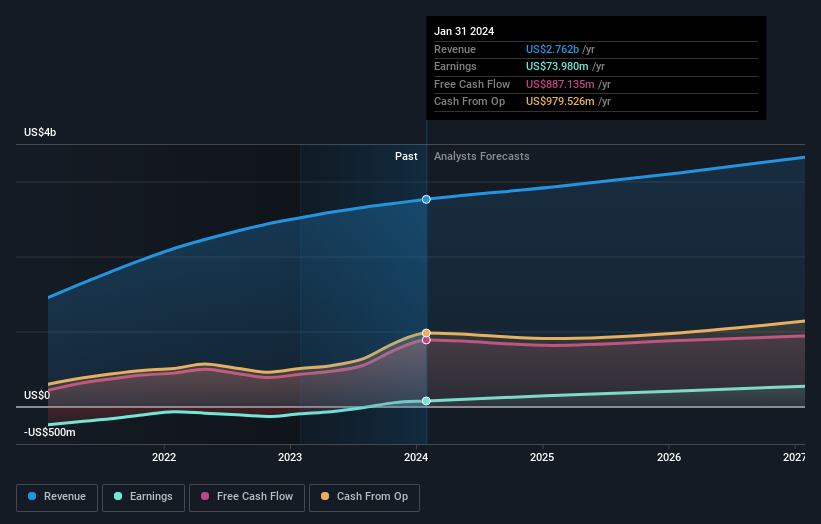- United States
- /
- Software
- /
- NasdaqGS:DOCU
Results: DocuSign, Inc. Beat Earnings Expectations And Analysts Now Have New Forecasts

It's been a good week for DocuSign, Inc. (NASDAQ:DOCU) shareholders, because the company has just released its latest yearly results, and the shares gained 2.6% to US$58.27. It looks like a credible result overall - although revenues of US$2.8b were in line with what the analysts predicted, DocuSign surprised by delivering a statutory profit of US$0.36 per share, a notable 16% above expectations. The analysts typically update their forecasts at each earnings report, and we can judge from their estimates whether their view of the company has changed or if there are any new concerns to be aware of. We thought readers would find it interesting to see the analysts latest (statutory) post-earnings forecasts for next year.
See our latest analysis for DocuSign

Taking into account the latest results, the consensus forecast from DocuSign's 23 analysts is for revenues of US$2.93b in 2025. This reflects a satisfactory 5.9% improvement in revenue compared to the last 12 months. Statutory earnings per share are predicted to soar 93% to US$0.69. Before this earnings report, the analysts had been forecasting revenues of US$2.93b and earnings per share (EPS) of US$0.70 in 2025. The consensus analysts don't seem to have seen anything in these results that would have changed their view on the business, given there's been no major change to their estimates.
It will come as no surprise then, to learn that the consensus price target is largely unchanged at US$65.10. The consensus price target is just an average of individual analyst targets, so - it could be handy to see how wide the range of underlying estimates is. The most optimistic DocuSign analyst has a price target of US$93.00 per share, while the most pessimistic values it at US$48.00. This is a fairly broad spread of estimates, suggesting that analysts are forecasting a wide range of possible outcomes for the business.
Taking a look at the bigger picture now, one of the ways we can understand these forecasts is to see how they compare to both past performance and industry growth estimates. It's pretty clear that there is an expectation that DocuSign's revenue growth will slow down substantially, with revenues to the end of 2025 expected to display 5.9% growth on an annualised basis. This is compared to a historical growth rate of 27% over the past five years. By way of comparison, the other companies in this industry with analyst coverage are forecast to grow their revenue at 12% per year. Factoring in the forecast slowdown in growth, it seems obvious that DocuSign is also expected to grow slower than other industry participants.
The Bottom Line
The most important thing to take away is that there's been no major change in sentiment, with the analysts reconfirming that the business is performing in line with their previous earnings per share estimates. On the plus side, there were no major changes to revenue estimates; although forecasts imply they will perform worse than the wider industry. There was no real change to the consensus price target, suggesting that the intrinsic value of the business has not undergone any major changes with the latest estimates.
With that in mind, we wouldn't be too quick to come to a conclusion on DocuSign. Long-term earnings power is much more important than next year's profits. We have forecasts for DocuSign going out to 2027, and you can see them free on our platform here.
And what about risks? Every company has them, and we've spotted 2 warning signs for DocuSign you should know about.
New: Manage All Your Stock Portfolios in One Place
We've created the ultimate portfolio companion for stock investors, and it's free.
• Connect an unlimited number of Portfolios and see your total in one currency
• Be alerted to new Warning Signs or Risks via email or mobile
• Track the Fair Value of your stocks
Have feedback on this article? Concerned about the content? Get in touch with us directly. Alternatively, email editorial-team (at) simplywallst.com.
This article by Simply Wall St is general in nature. We provide commentary based on historical data and analyst forecasts only using an unbiased methodology and our articles are not intended to be financial advice. It does not constitute a recommendation to buy or sell any stock, and does not take account of your objectives, or your financial situation. We aim to bring you long-term focused analysis driven by fundamental data. Note that our analysis may not factor in the latest price-sensitive company announcements or qualitative material. Simply Wall St has no position in any stocks mentioned.
About NasdaqGS:DOCU
DocuSign
Provides electronic signature solution in the United States and internationally.
Undervalued with solid track record.
Similar Companies
Market Insights
Community Narratives




